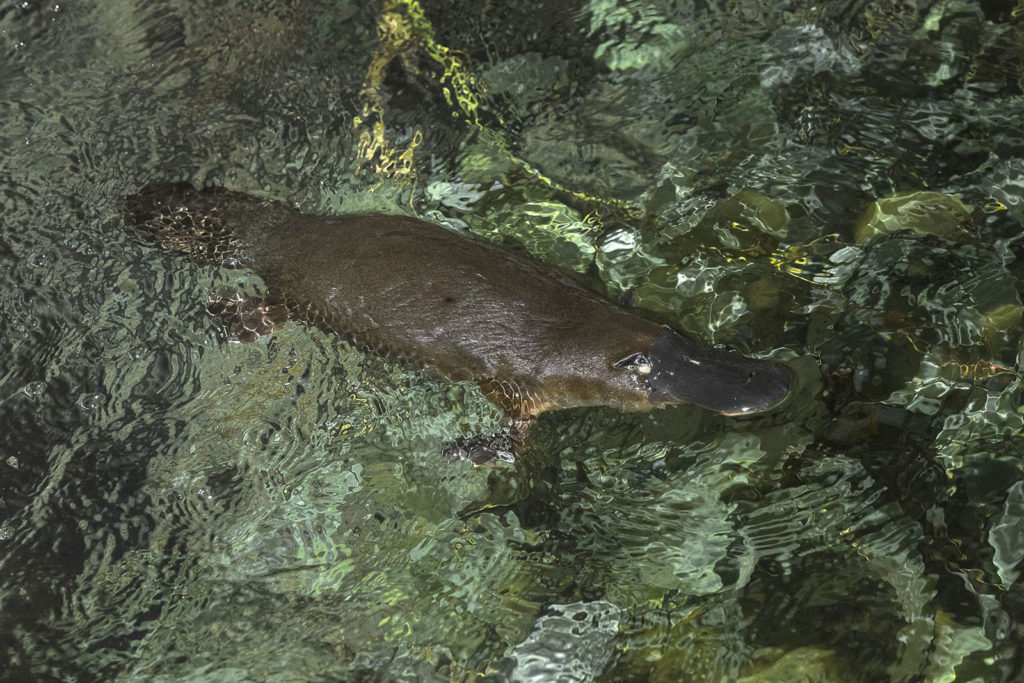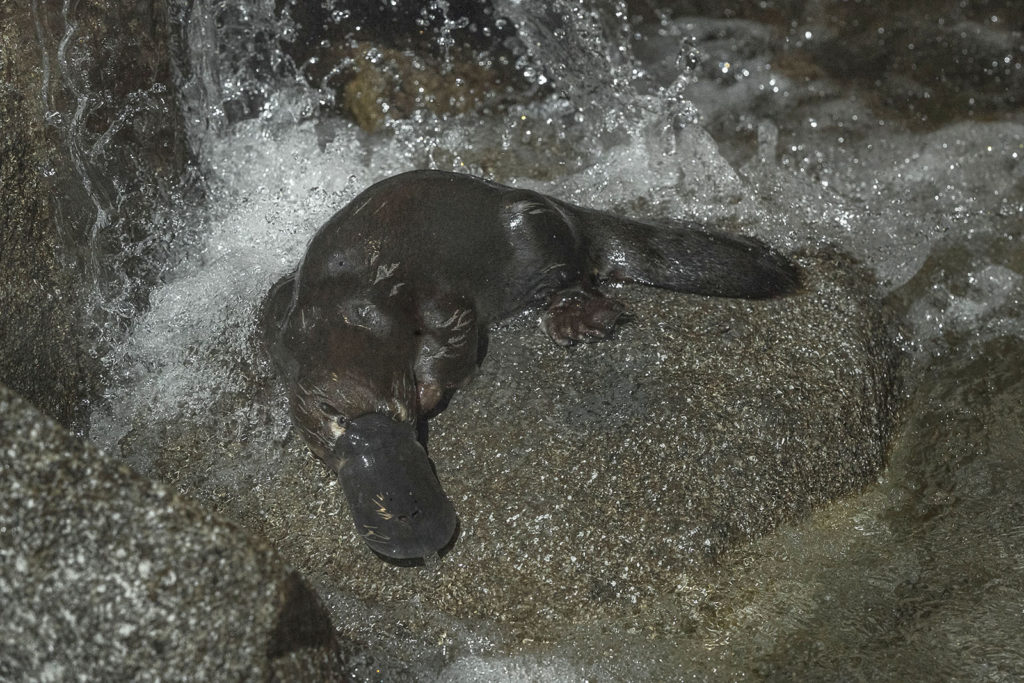
Routine Health Exam Finds Eve, One of Only Two Ambassadors for the Species Outside of Australia, Is “Doing Exceptionally Well”
One of the San Diego Zoo Safari Park’s newest residents, a female platypus named Eve, underwent a routine veterinary health check the morning of (Dec. 5, 2019), and was found to be “doing exceptionally well,” according to Dr. Meredith Clancy, Safari Park associate veterinarian. Keeper Luis Ochoa placed the platypus on a scale and then lifted her out of her nest, while Dr. Clancy checked Eve’s body condition and tail volume—an indicator of the platypus’ fat storage and weight maintenance.
“Eve and Birra (the Safari Park’s male platypus) are both doing extremely well since they arrived at the Safari Park,” Dr. Clancy said. “We routinely monitor their body condition as an indicator of their overall health. Since platypuses live in water and have excess skin and fur, it makes it hard to see if they are too thin or too fat. They store a lot of their fat in their tail, so we do a tail volume index (TVI)—where we can see how chunky their tail might be—to ensure they are eating well and maintaining their weight.”
The platypus is a semiaquatic, egg-laying mammal found along the eastern coast of Australia, within the states of Queensland, New South Wales, Victoria and Tasmania. They live in freshwater streams, creeks and rivers. Platypuses are unique in appearance, having a long snout resembling a duck’s bill, a beaver-like tail, webbed feet and dense fur. They are excellent swimmers, paddling with their front webbed feet and steering with their hind feet and tail. While swimming, folds of skin cover their eyes and ears to prevent water from entering, and their nostrils close with a watertight seal. They can remain submerged for about 20 to 40 seconds at a time.
Platypuses vary in size in different geographical regions, but they usually are about the size of a domestic cat. They typically measure between 12 and 24 inches long, and their weight ranges from 2 to 4 pounds. Eve, age 15, currently weighs about 2.5 pounds; and 8-year old Birrarung (called “Birra”) weighs almost 3 pounds.
Eve and Birra were flown to San Diego from their home at Australia’s Taronga Zoo Sydney in late October, to serve as ambassadors for the species outside of their native Australia. The San Diego Zoo Safari Park is currently the only zoo outside of Australia to house platypuses—and this is the first time in more than 50 years that platypuses have been cared for outside of Australia. The Nelson M. Millsberg Platypus Habitat at the Safari Park’s Walkabout Australia officially opened Nov. 22, 2019.
The Safari Park’s world-class platypus habitat includes three pools, naturalistic river banks, extensive tunnels and nesting areas. The habitat was built more than a year ago, in anticipation of the platypuses’ arrival, through the generous gifts of more than 500 donors. Many months of preparation and staff training went into ensuring the successful transfer and ongoing care of the platypuses. To appropriately care for the species, Dr. Clancy, Ochoa and two additional Safari Park keepers, traveled to Australia to train in platypus husbandry and health care for several months. Safari Park animal care specialists report that the two platypuses have acclimated very well. They are foraging and hunting for crayfish, swimming in their pools, splashing in their waterfalls and building nests.
In the wild, platypuses are most active during dusk and nighttime hours, and they generally sleep during the day. To allow Safari Park guests the best viewing opportunity, and still provide the optimum environment for the platypus pair, the Safari Park’s animal care specialists have reversed the lighting cycle in their habitat—so that it mimics nighttime during our daylight hours and daytime during our nighttime hours. Platypuses can be difficult to see, both in the wild and in a zoological setting, so getting a glimpse of these elusive, busy animals is a rare and special experience, Ochoa said.

These special animals serve as ambassadors for the species outside of their native Australia and communicate the importance of fresh water for both humans and wildlife. Freshwater resources and habitats are being affected by pollution and climate change. People are encouraged to be part of the solution, and protect wildlife through water conservation measures and practices that help slow climate change.
To understand what is occurring with platypuses in Australia—and to better understand the conditions they live in, and those affecting other river species—San Diego Zoo Global has pledged an ongoing commitment of funds to field conservation of platypuses. San Diego Zoo Global, the University of Melbourne and the conservation group cesar have teamed up to begin a unique project designed to learn more about the elusive platypus and the threats to its survival. The project uses innovative technology, in which samples of water are tested for traces of environmental DNA (eDNA) to learn about the species present in freshwater ecosystems. This is the largest survey undertaken for platypuses and will allow researchers to comprehensively map their current distribution. The information will guide future steps for the protection of platypuses and the ecosystems they depend on throughout Victoria and New South Wales. The ongoing study is also important to help better understand and evaluate how human activity is affecting this species.

The platypus is listed as Near Threatened on the International Union for Conservation of Nature (IUCN) Red List of Threatened Species, primarily due to habitat destruction, climate change, predation and direct human contact. Scientists do not know the number of platypuses in the wild, but estimates range from 10,000 to 100,000.
Guests can visit the new platypus habitat at Walkabout Australia during regular Safari Park hours.
As an international nonprofit organization, San Diego Zoo Global works to fight extinction through conservation efforts for plants and animals worldwide. With a history of leadership in species recovery and animal care, San Diego Zoo Global works with partners in science-based field programs on six continents, and maintains sanctuaries and public education facilities in many places. Inspiring a passion for nature is critical to saving species, and San Diego Zoo Global’s outreach efforts share the wonder of wildlife with millions of people every year. Current major conservation initiatives include fighting wildlife trafficking and the impacts of climate change on wildlife species; broad-spectrum species and habitat protection efforts in Kenya, Peru and on islands worldwide; preventing extinction in our own backyard; and expanding efforts to bank critical genetic resources and apply them to the conservation of critically endangered species. To learn more, visit SanDiegoZooGlobal.org or connect with us on Facebook.




